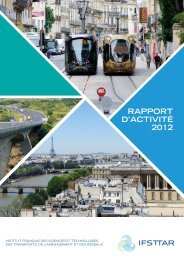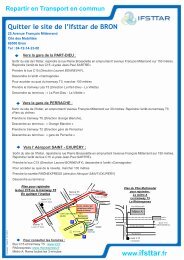french institute of science and technology for transport ... - Ifsttar
french institute of science and technology for transport ... - Ifsttar
french institute of science and technology for transport ... - Ifsttar
You also want an ePaper? Increase the reach of your titles
YUMPU automatically turns print PDFs into web optimized ePapers that Google loves.
3_APPLICATION OF RESEARCH FINDINGS, TIES WITH INDUSTRY AND EXPERT APPRAISALS<br />
In 2011, the group conducted chemical tests on 387 additives<br />
<strong>and</strong> 11 curing products <strong>and</strong> physical tests on 39 additives<br />
<strong>and</strong> 2 curing products. In addition, it organized <strong>and</strong><br />
analyzed the results <strong>of</strong> the intra- <strong>and</strong> inter-laboratory tests <strong>for</strong><br />
COFRAC in order to determine the measurement uncertainties<br />
<strong>of</strong> the chemical tests.<br />
@ CONTACT<br />
philippe.briquet@ifsttar.fr<br />
84<br />
Infrared spectrometer <strong>for</strong> characterizing<br />
additives <strong>and</strong> curing products.<br />
IFSTTAR helps open<br />
Line 1 on the Algiers metro line<br />
Early November 2011 saw the opening <strong>of</strong> the first metro<br />
line in Algiers.<br />
After two years <strong>of</strong> work supporting the rail certification<br />
agency CERTIFER, ESTAS approved the safety demonstration<br />
documents <strong>for</strong> the Siemens France automatic driver system.<br />
This is the second heavy metro system to be built in Africa <strong>and</strong><br />
ESTAS had already carried out the expert appraisal <strong>for</strong> the first,<br />
in Cairo, in the 1990s.<br />
On the Algiers line, CBTC (Control Based Train Communication)<br />
devices automatically control train driving, compliance<br />
with speed limits, headways <strong>and</strong> stopping points, with the<br />
human driver only operating the doors <strong>and</strong> giving the authorization<br />
to leave the station. The principle is <strong>for</strong> the automatic<br />
devices on the train to transmit the exact position <strong>of</strong> the train<br />
to the automatic devices on the ground on a continuous basis.<br />
The equipment on the ground determines the stops the train<br />
must make to guarantee safety <strong>and</strong> transmits them to each<br />
train. The individual trains then optimize their speed in order to<br />
ensure safe movements <strong>and</strong> compliance with operating goals.<br />
The <strong>technology</strong> uses massive coding <strong>of</strong> data <strong>and</strong> implements<br />
safety-critical s<strong>of</strong>tware developed <strong>and</strong> tested using <strong>for</strong>mal<br />
methods (method B).<br />
Line 1 <strong>of</strong> the Algiers metro.<br />
@ CONTACT<br />
marielle.cuvelier@ifsttar.fr<br />
ifsttar French Institute <strong>of</strong> Science <strong>and</strong> Technology <strong>for</strong> Transport, Development <strong>and</strong> Networks






![Trajectoire le magazine n°3 - Juillet 2012 [.pdf] - Ifsttar](https://img.yumpu.com/30038493/1/190x253/trajectoire-le-magazine-na3-juillet-2012-pdf-ifsttar.jpg?quality=85)

